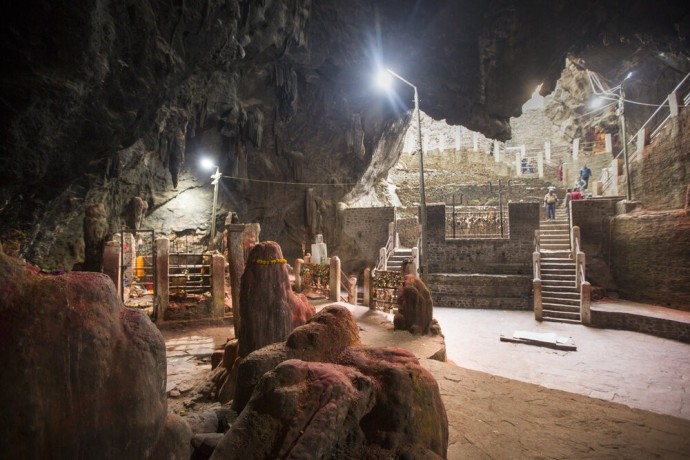Halesi Mahadev Temple: Where Divine Reverence Meets Natural Splendor in Eastern Nepal Professional
Oct 21st, 2023 at 09:24 Blogs Khotang 579 views Reference: 793Location: Khotang
Price: Contact us
Introduction
Nestled amidst the pristine landscapes of the Khotang district in eastern Nepal, the Halesi Mahadev Temple stands as a beacon of spiritual significance and natural beauty. This ancient temple, associated with Lord Shiva, has earned its place among the holiest sites in eastern Nepal, drawing pilgrims, devotees, and curious travelers alike. In this article, we embark on a mystical journey to explore the profound religious heritage, cultural importance, and the enchanting natural surroundings that make Halesi Mahadev Temple a revered destination and a testament to Nepal’s spiritual legacy.
Historical and Mythological Significance
The history of Halesi Mahadev Temple dates back thousands of years, and it is interwoven with ancient myths and legends. According to Hindu mythology, Lord Shiva chose Halesi as a place to hide from the demon Bhasmasur, granting the region its sanctity and religious prominence. The temple is often referred to as "Pashupatinath of the East," a title befitting its reverence among devotees.
Architectural Marvels: A Sanctuary of Divinity
The architecture of Halesi Mahadev Temple exudes an aura of sacredness and antiquity. The temple complex is a harmonious blend of traditional Newari and Tibetan architectural styles. The main temple structure is adorned with intricate carvings, depicting mythological figures and divine motifs. Pilgrims are greeted by a grand entrance gate, leading them into a courtyard that resonates with the echoes of prayers and the soft chiming of bells.
Inside the temple, the sanctum sanctorum houses the sacred Shiva Lingam, a representation of Lord Shiva. The atmosphere within is suffused with the heady aroma of incense, creating a serene ambiance that invites visitors to meditate and offer their prayers.
Natural Splendor: The Enchanting Surroundings
What sets Halesi Mahadev Temple apart is not just its religious significance but also the breathtaking natural beauty that surrounds it. The temple is nestled within a limestone cave, adding an element of mystique to the pilgrimage experience. Outside the cave, the lush greenery of the hills and the pristine air create a serene backdrop against which the temple stands resplendent.
The region around Halesi Mahadev Temple is dotted with scenic spots, including waterfalls, caves, and verdant hills. Pilgrims often embark on treks to explore these natural wonders, turning their pilgrimage into a holistic experience that rejuvenates the body and soul.
Cultural Importance: Pilgrimage and Festivals
Halesi Mahadev Temple is a center of religious pilgrimage, drawing devotees not only from Nepal but also from India and other neighboring countries. Pilgrims embark on arduous journeys to seek the blessings of Lord Shiva, believing that their prayers and offerings will be met with divine grace.
The temple comes alive during religious festivals, especially during Maha Shivaratri, when fervent devotees gather to participate in elaborate rituals, prayers, and processions. The vibrant atmosphere, marked by devotional songs and colorful decorations, creates an aura of celebration, making these festivals unforgettable experiences for pilgrims.
Community Spirit and Preservation Efforts
The preservation of Halesi Mahadev Temple is a shared endeavor, involving the local community, religious authorities, and heritage conservation organizations. Restoration projects focus on maintaining the temple's architectural integrity, ensuring that its intricate carvings and structures remain intact for future generations.
Community engagement initiatives play a vital role in raising awareness about the temple's cultural and religious importance. Educational programs, workshops, and guided tours are organized to inform the local populace and visitors about the significance of Halesi Mahadev Temple, fostering a sense of pride and responsibility within the community.
Conclusion: Halesi Mahadev Temple—A Spiritual Oasis in Eastern Nepal
In the heart of the Khotang district, Halesi Mahadev Temple stands as a testament to the enduring faith of Nepal's people and the sublime beauty of its natural surroundings. It is more than just a temple; it is a sanctuary where divine reverence meets the enchanting splendor of nature. Pilgrims and travelers who visit Halesi Mahadev Temple find themselves immersed in a world where spirituality is intertwined with the very fabric of the land.
The temple becomes a sacred space where the boundaries between the earthly and the divine blur, where prayers echo through ancient cave walls, and where the presence of Lord Shiva is felt in the rustle of leaves and the murmuring of streams. Halesi Mahadev Temple is not just a destination; it is a transformative journey, a pilgrimage of the soul that leaves an indelible mark on the hearts of those who venture into its hallowed caves and verdant hills.
As the sun sets over the hills of eastern Nepal, the silhouette of Halesi Mahadev Temple stands against the darkening sky, a beacon of spiritual light that continues to guide the faithful and inspire the curious. In the tranquility of its surroundings and the sanctity of its chambers, Halesi Mahadev Temple remains a spiritual oasis, inviting all who seek divine blessings and inner peace to experience the profound serenity that defines this sacred place in the heart of eastern Nepal.






